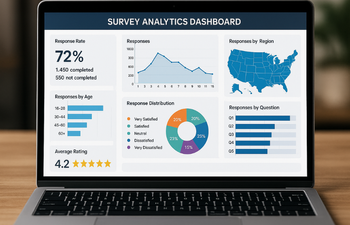Email, SMS, or In-App? Best Channels for Sending Your Surveys
Explore whether email, SMS, or in-app is the best survey distribution channel for your business goals.

Introduction
Choosing the right channel to distribute surveys is just as important as crafting the questions themselves. Should you rely on tried-and-true email campaigns, opt for the immediacy of SMS, or leverage the contextual timing of in-app messages? With each method offering distinct advantages, and some notable drawbacks, understanding when and why to use each is vital for collecting meaningful, actionable feedback.
Why Survey Distribution Channels Matter
Surveys are only as good as the responses they receive. Distribution channels not only affect response rates but also influence the quality and honesty of the feedback. Your audience’s behavior, preferences, and context all play a role in determining which channel is most effective. Considerations such as immediacy, formality, and integration into user workflows are critical.
Understanding the psychology behind how people respond is just as important as choosing the right channel. For a deeper dive into reducing bias and getting honest feedback, check out Online Survey Psychology: How to Reduce Bias and Get Honest Responses.
Overview of Survey Distribution Channels
Before diving deeper, here’s a quick comparison of the primary channels.
Email Surveys: The Classic Choice
Email surveys are a cornerstone of feedback collection. They offer the flexibility to present longer, more detailed forms and are ideal for post-purchase evaluations or periodic NPS surveys.
Pros of Email Surveys
- High familiarity among users
- Ability to include branding and visuals
- Good for long-form feedback
Personalization and Timing
Personalization greatly impacts survey effectiveness. Addressing users by name, referencing their activity, and choosing the right moment can boost response rates. Timing, especially in SMS and in-app, plays a crucial role, interruptions must be minimized.
Multi-Channel Survey Strategy
Why choose one channel when you can blend several? A multi-channel approach broadens your reach and allows users to respond through their preferred method.
- Start with SMS for immediacy
- Follow up via email for those who didn’t respond
- Trigger in-app surveys during relevant interactions
Integrating Surveys with CRM and Analytics
All feedback should feed into your CRM or analytics stack. Tools like HubSpot, Salesforce, or custom dashboards help centralize insights from all survey channels.
Ensuring Compliance and Data Privacy
Different channels have different legal implications. For instance, GDPR mandates explicit consent for SMS messages. Always provide a clear privacy policy and opt-out options.
User Experience Considerations
Surveys should be frictionless. Poor UX can reduce trust and skew results. Use progress indicators, thank-you messages, and mobile-optimized formats.
A/B Testing Survey Channels
Experimentation helps determine what works best for your audience. A/B test subject lines, timing, and formats to refine your strategy.
Survey Fatigue and How to Avoid It
Bombarding users with too many surveys can lead to fatigue. Space out requests and make each survey feel meaningful and quick.
Segmenting Your Audience
Different users prefer different channels. Segment by demographics, behavior, or lifecycle stage to tailor the experience and increase engagement.
Feedback Loop Closure
Always follow up with respondents. Share what’s been done with their feedback. It builds trust and increases the likelihood of future participation.
Real-World Case Studies
SaaS Startup Example
A SaaS company improved feature adoption by using in-app surveys right after feature use, followed by targeted email follow-ups for inactive users.
E-Commerce Brand
An e-commerce brand found that SMS yielded twice the feedback rate compared to email after purchases, with significantly faster response times.
Future Trends in Survey Channels
Expect more automation, predictive distribution based on user behavior, and even conversational AI integrations. Voice-based feedback through smart devices is on the horizon too.
Final Thoughts on Email, SMS, or In-App?
There's no one-size-fits-all answer. The best survey channel depends on your audience, goals, and context. Email remains powerful for long-form insights. SMS shines in immediacy. In-app delivers context-rich feedback. Use them wisely, ideally together, for a robust feedback strategy.
Email, SMS, or In-App? Best Channels for Sending Your Surveys
When faced with the question of which survey channel is best, email, SMS, or in-app, the answer isn’t clear-cut. But one thing is: your strategy must be intentional. The right channel at the right time can drive extraordinary insights and stronger customer relationships.
Frequently Asked Questions
Find answers to the most common questions about this topic
Each channel has strengths: email for depth, SMS for speed, and in-app for real-time feedback.
Yes, provided users have opted in and proper data privacy measures are followed.
In-app surveys are best for capturing contextual feedback during or immediately after app use.
Yes, multi-channel distribution can increase reach and response rates when coordinated properly.
Yes, email surveys remain a popular choice for long-form responses and B2B audiences.
Typically, in-app and SMS surveys see the highest response rates due to immediacy and brevity.









